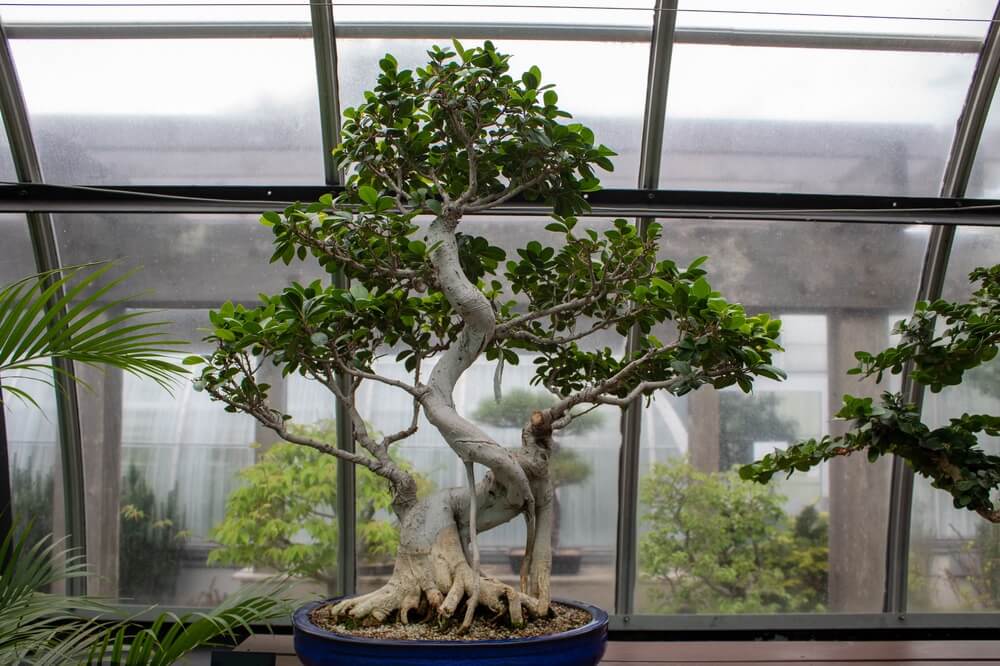The Ficus retusa is a prolific grower hailing from the Southeast Asian region of Malesia and the Malay archipelago. This tropical evergreen can be grown as a normal house plant or can be grown as a bonsai. Ficus retusa care is relatively easy and when done correctly, will lead to stunning results.
Table of contents
The Ficus retusa, also commonly referred to as the Bayan Fig, is one of the most popular species of bonsai trees. Bonsai is an ancient Japanese art form that is still practiced to this day. Bonsai is the practice of artificially cultivating and growing dwarfed trees or shrubs. When grown as a bonsai tree, the Ficus retusa is kept to a miniature height of two to three feet, however it can be left to grow and flourish to many feet high.
This post will walk you through all the important aspects of Ficus retusa care. Let’s get started!
Quick Facts

- Common Name: Bayan Fig, Ficus retusa bonsai
- Scientific Name: Ficus retusa
- Mature Size: 2’-3’ tall as a bonsai, up to 33’ tall in nature
- Sunlight: full sun
- Water: when top ½”-1” of soil is dry
- Soil: well-draining mix of organic soil with large particles such as pumice or lava rock
- Temperature: 65°F-75°F
- Propagation: stem cuttings, leaves
- Hardiness Zone: 10b-11
- Toxicity: toxic to pets and humans
Growth Pattern and Habits
The beautiful Ficus retusa can be grown in two different ways which leads to two very distinct growth patterns. If left to grow as it would in nature, an indoor, potted Ficus retusa will grow to a small sized tree. If you prefer an ornamental miniature version and want to take the time to grow your Ficus retusa as a bonsai, this plant is usually kept under two to three feet tall.
Regardless of how you choose to let your plant grow, the Ficus retusa’s growth rate is fast! When given proper care, a Ficus retusa can grow up to two feet per year! Not only is this plant a fast grower, it also has a lifespan upwards of one hundred years.

Ficus retusa has thick, waxy oval shaped leaves with a pointed tip. The leaves are a deep olive green and create a dense canopy. The trunk and stems are woody and gray in color. These trees tend to have curvy, S-shaped trunks.
Sunlight
To understand a Ficus retusa’s light requirements, it’s good to understand their natural habitat. Native to southeast Asia, the Ficus retusa is a large, towering tree that grows over thirty feet tall outdoors. They are often grown in parks and along streets to provide some shade to people who live in this sunny region. Because these trees grow so tall in their native environment, it’s no surprise that an indoor Ficus retusa loves full sun!
Position your Ficus retusa in a window that receives at least four to six hours of direct sunlight daily. This area of your house should be consistently bright even when the sun is not shining directly into the window. If you live in the northern hemisphere, this room will have south facing windows. If you live in the southern hemisphere, place your Ficus retusa in a north facing window.
Expert Tip – Clean your Ficus retusa’s leaves weekly with a damp cloth to remove dust and grime. This allows your plant to better photosynthesize!
Water
It is important to water your Ficus retusa with room temperature water. Always check the soil before watering instead of sticking to a strict schedule. It is best to water a Ficus retusa when the top half inch to inch of soil is dry to the touch.
Water thoroughly! Continue pouring watering around the plant’s base until you see water running out of the bottom drainage hole. Allow excess water to drain out of the pot either into your sink, bathtub or drainage plate.
Expert Tip – It is best to plant your Ficus retusa bonsai in a shallow but wide pot. This pot should absolutely have a drainage hole! After a Ficus retusa watering, be sure to dump the excess water out of the drainage tray.
Soil
The optimal Ficus retusa soil is one that is able to hold onto proper amounts of moisture, has adequate drainage and is well aerated. The following homemade recipe is one that I find to work best for a Ficus retusa. All parts can be found at gardening stores or specialty online bonsai retailers.
- ⅓ parts organic potting soil
- ⅓ parts pumice
- ⅓ parts lava rock
It is extremely important to mix these components for an even distribution. The organic soil provides nutrition necessary for the plant’s health. Pumice and lava rock are both composed of large particles. These large particles prevent soil from compacting around the root ball, which allows oxygen to be more readily absorbed.
Temperature and Humidity
The Ficus retusa is not frost tolerant. It is happiest in balmy temperatures between 65°F-75°F and does great in average household environments. Feel free to grow your Ficus retusa outside if you live in an area where temperatures don’t consistently drop below 60°F.
Expert Tip – The key to a happy Ficus retusa is consistent temperatures! Avoid large fluctuations in temperatures between the day and night. Don’t place your Ficus retusa outside if temperatures regularly top 90°F.
Moderate levels of humidity are best for the Ficus retusa. This plant is happy with a daily light misting of water to keep humidity levels on the higher side. A strict misting schedule is not necessary, however, as it will do just fine due to its waxy leaves.
Fertilization
Because the Ficus retusa grows quickly, it does require regular fertilization. Fertilize your Ficus retusa every two weeks in the summer growing months. If you still notice ample new growth in the winter, you can continue this schedule. If growth slows, only fertilize once a month.
Choose a balanced liquid fertilizer and dilute the fertilizer to half strength.
Propagation
Ficus retusa propagation can be done using two different methods. You can propagate a Ficus retusa using stem cuttings or leaves. Let’s discuss the details of each method.

Propagation by Stem Cuttings
- Identify healthy stems that are at least six inches long with numerous leaves.
- Using a pair of sterile scissors or pruners, remove stems from the mature plant using a clean, diagonal cut.
- Leave the new Ficus retusa cuttings out to dry over for three to five days. This allows a callus to form over the fresh cut.
- Plant each cutting into fresh soil. Keep soil moist by gently watering or misting daily.
- Roots should begin to form over the next three weeks. Lightly pull on each cutting. If you feel resistance, roots have begun to mature and you can now care for your new Ficus retusa as detailed in the sections above!
Propagation by Leaves
- Using sterile pruning scissors, remove healthy leaves at the point where the leaf meets the stem, leaving the petiole (or stalk) attached to the leaf.
- Fill a shallow container or vessel with water. Place each leaf in the water. Ensure that only the petiole is submerged in water, not the leaf. Replace water every few days or when you notice the water is becoming cloudy or discolored.
- Roots should be noticeable after six weeks. At this time, plant the rooted leaves in their own pots with fresh soil.
Bonsai Basics
There are a couple additional things you need to know in order to care for your Ficus retusa bonsai. All of the Ficus retusa care information detailed above, such as light requirements and watering needs, are the same. What I want to talk about now is the maintenance needed to keep this plant miniature and ornamental.
Because the Ficus retusa bonsai grows quickly, it is important to keep up on pruning and defoliation. Both techniques are done to maintain the plant’s shape, small size and overall health.
Pruning is important for a couple of reasons. Regular pruning is necessary in order to remove aging leaves to keep your bonsai Ficus retusa healthy and pest and disease free. Secondly, pruning is used to maintain a specific ornamental shape. A prunable stem is one that has at least six leaves. Prune the stem by cutting the stem two leaves back from the end. Don’t throw these away; you can use these Ficus retusa cuttings for propagation.
Expert Tip – You can prune your Ficus retusa bonsai multiple times per year, but do not prune more than ⅓ of the whole plant at a time!
Defoliation results in more growth while keeping leaf size small. Defoliation is the removal of some, most or all leaves from the stems. This can be done using pruning scissors or by hand. Only defoliate your bonsai Ficus retusa once a year in June. Once leaves are removed, expect to see new growth within two weeks!
Common Issues
The Ficus retusa is a hardy plant but still experiences some issues that you should be ready for so you can act quickly.
Leaves Dropping
Older leaves, which are on the lower branches and closer to the trunk, drop as part of their growth cycle. When leaves throughout your Ficus retusa are dropping, this is cause for concern. The most common reasons that a Ficus retusa drops its leaves are due to too little light and lower than optimal humidity.

Luckily these causes are both easy fixes! A Ficus retusa needs at least four to six hours of direct sunlight per day, so evaluate where you are housing your plant. To increase humidity, you can gently mist the plant daily or add a pebble tray underneath the pot.
Pests
Spider mites and scale are the most common pests to infect a Ficus retusa. Both can be treated by removing all visible signs of the insects with an alcohol soaked cotton ball followed by bi-weekly treatments of neem oil.
Be sure to isolate any infected plant so the pests don’t spread to your entire plant collection!
Root Rot
If you have proper soil and are watering your Ficus retusa only when the top inch of soil is dry, you shouldn’t have to worry about root rot. However, if this plant is chronically overwatered, root rot can occur.
A Ficus retusa with root rot will have yellowed leaves, extremely slowed growth and a discolored stem. Gently remove the plant from its container. Using sterile scissors remove all affected roots (these will be brown or black and mushy to the touch!). Spray the healthy roots with water to remove excess soil then allow it to dry over a twenty four hour period. Repot either in a new pot or in the original container once sterilized.
Toxicity
The Ficus retusa is toxic to both pets and humans. Someone who has ingested any part of the Ficus retusa may show the following symptoms: vomiting, drooling, skin irritation and/or distress. These are not all of the possible symptoms so it is important to contact the appropriate emergency services immediately if ingestion is suspected.
Wrapping Up
The Ficus retusa can be grown into a large houseplant or into an ornamental bonsai. Both bring character and intrigue to any space. Ficus retusa care is easy to master while pruning and defoliation can take some time!




